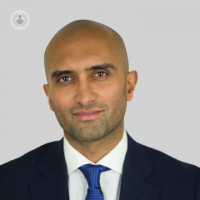Is knee joint preservation surgery an alternative to knee replacement surgery?
Written by:Osteoarthritis is one of the most common types of arthritis and the pain, swelling and stiffness felt in the knee may be enough for someone to consider knee joint replacement surgery. Nowadays, however, joint preservation surgery (or osteotomy) is becoming a more popular treatment to prevent or delay the onset of osteoarthritis, especially in younger patients.
We spoke to one of our specialist knee surgeons Mr Bilal M. Barkatali about joint preservation surgery and here he explains all that you need to know about the treatment option.

What is knee joint preservation surgery?
Knee joint preservation surgery is a new philosophy in the sphere of knee surgery, which aims to preserve the human knee for as long as possible. This has come about over the last three decades of joint replacement surgery, being the mainstay of treatment for degenerative knee disease.
We have found through research and a collection of outcomes that knee joint preservation surgery is successful in around 85% of cases and that following knee replacement, a further operation is required to re-do the knee replacement usually after around 10 to 15 years. As patients are developing knee joint degenerative problems at a younger age, we have developed different approaches to avoid the need for knee replacement surgery.
When is this treatment offered?
Joint preservation surgery is offered after a thorough assessment, including patient history, clinical examination, X-rays of the knee and long leg alignment views. The long leg alignment views allow the clinician to assess the patient’s mechanical loading access. This helps us to find out at which point through the knee the load is passing.
Humans have three different types of alignment. There is a neutral alignment, which is a straight leg, a varus alignment, which appears as bowed legs, and valgus alignment which appears as knocked knees.
If patients have bowed legs or knocked knees and subsequent to that have worn out one specific part of their knee (either the medial or lateral side of the joint) then the underlying pathology, which is the mechanical malalignment, can be corrected. This is called osteotomy surgery and can be combined with biological therapies, such as platelet-rich plasma injections to maintain the cartilage in the knee joint.
How is it performed?
Joint preservation surgery, or osteotomy surgery, is performed after a thorough clinical assessment and calculation of all the angles of the lower leg. The calculations are then used to perform osteotomy surgery, which involves making an incision in the bone in two plains and realigning the lower leg.
Once the limb has been realigned and is straight with the mechanical access passing through the desired point within the middle of the knee joint, a plate is applied to either the femur or the tibia to maintain the alignment while the bone heals.
What does aftercare involve?
The aftercare involves protected weight-bearing with crutches for around six weeks after which weight bearing can be resumed. The patient is then followed up in the clinic with X-rays to make sure that the correct alignment has been achieved and that the bone goes on to union.
Should any aspects of lifestyle change before/after surgery?
The aim of joint preservation surgery is to maintain the human knee, which is the best possible knee joint that one can have. The aim of the surgery is to maintain a patient's active lifestyle, which allows them to, for example, go running, cycling and perform any other type of sport that they want. This is not usually possible following a knee replacement surgery. Therefore the aim of the surgery is to maintain the lifestyle rather than alter it in any way.
Will all joint preservation patients need replacement surgery eventually?
The results of joint preservation /osteotomy surgery are generally very good with 85% of patients not requiring joint replacement surgery after 10 years. This means that only 15% of those patients will go on to require a joint replacement operation.
The reason for this is that osteoarthritis is a progressive condition and despite the realignment of the leg the osteoarthritis can continue. More modern techniques, as well as adding biological therapies into the knee joint, can delay knee replacement surgery even further.
Would you like Mr Bilal’s expert opinion in your case of knee pain? You can make an appointment to see him via his Top Doctor’s profile here.


